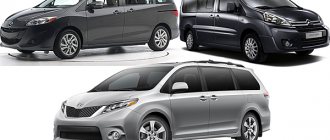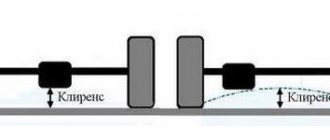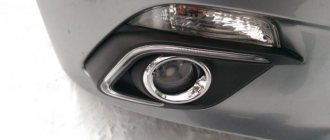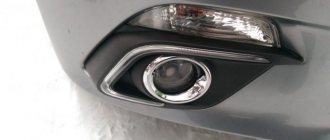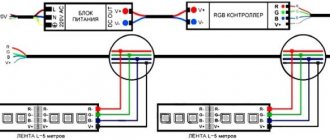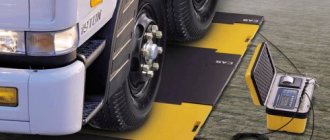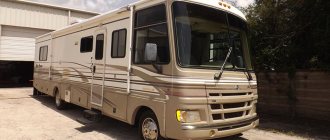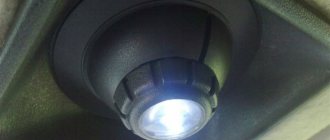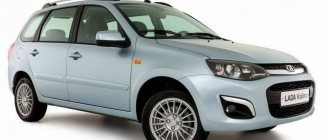Ground clearance is the distance between the road surface and the lowest point in the center of the vehicle.
Ground clearance differs on different cars; the car may have:
- large (high) ground clearance (from 20 cm);
- average ground clearance (15-18 cm);
- small ground clearance (less than 13 cm).
It is important to understand that ground clearance has a significant impact on cross-country ability, controllability, stability and a number of other indicators. For this reason, it is necessary to separately take into account a number of nuances when choosing a car. Read more in our article.
Ground clearance: what is car clearance and what does it affect?
First of all, ground clearance is the distance between the supporting surface and the lowest point of the central part of the car. Said central part is that part which is enclosed between two planes.
These planes are parallel to the longitudinal plane of symmetry of the car and stand the same (equal) relative to the inner surface of the wheels. At the same time, the amount of ground clearance is an important criterion for many car owners when buying a car.
Small ground clearance
The lower the car body is to the road, the better the car is controlled, the steering wheel is more responsive and clear, there is less sway and roll, the suspension is more “assembled” and “squeezed”. Such a car is more stable at high speeds and easier to drive.
However, cars with low ground clearance:
- it turns out to be too “low”, such a machine is difficult to operate in winter;
- difficulties arise in the city, driving outside the city is even more difficult;
Naturally, taking into account such nuances, drivers strive for high ground clearance. The fact is that even in large cities in the CIS, the condition of the roads is not the best.
Geometric cross-country ability of the car
The amount of ground clearance (clearance) is only one of the characteristics of the geometric cross-country ability of a car.
Geometric cross-country ability is a set of geometric parameters of a car that affect its ability to overcome obstacles.
The geometric cross-country ability of a car consists of basic and off-road parameters.
The basic parameters of geometric cross-country ability include:
- length, width and height of the machine.
- Wheelbase length
is the distance between the axles of the front and rear wheels. - Track width
is the distance between the centers of the wheels of one axle in the contact patch with the ground. - Front overhang
is the distance between the axle of the front wheels and the extreme forward point of the car. - Rear overhang
is the distance between the axle of the rear wheels and the rearmost point of the car.
Off-road parameters of geometric cross-country ability include:
- ground clearance (ground clearance)
- the distance from the lowest element of the car to the surface of the earth. - Approach angle
is the angle between the horizontal surface and the line drawn between the contact patch of the front wheels and the bottom point of the front of the car. The approach angle depends on the ground clearance and the length of the front overhang: the higher the ground clearance and the smaller the front overhang, the higher the approach angle will be. - Departure angle
is the angle between the horizontal surface and the line drawn between the contact patch of the rear wheels and the bottom point of the rear of the car. The departure angle depends on the ground clearance and the length of the rear overhang: the greater the clearance and the smaller the rear overhang, the greater the departure angle will be. - Ramp angle (longitudinal flotation angle)
is the maximum angle that a vehicle can overcome without touching the surface with its bottom. The ramp angle depends on a combination of ground clearance and wheelbase length: the higher the ground clearance and the shorter the wheelbase, the larger the ramp angle will be. - Rollover angle (angle of lateral static stability)
is the maximum angle of rotation of the vehicle around the longitudinal axis at which it may not tip over on its side. The rollover angle depends on a combination of the vehicle's width and height, its track width, and its center of gravity: the wider the vehicle and its track, the smaller the height and the lower the center of gravity, the higher the rollover angle.
The most important parameters of a car’s geometric cross-country ability are: ground clearance, approach and departure angles and ramp angle. To describe the parameters characterizing the cross-country ability of cars, automakers use these numbers.
Ground clearance (ground clearance) is the most important parameter of a car’s cross-country ability, because it directly affects most other parameters.
Increased ground clearance
High ground clearance allows you to drive more confidently on bad roads, overcome obstacles (drifts, curbs, deep holes) with less risk of damaging the body, bumpers, and components in the lower part of the car.
However, you should also understand that more does not always mean better. Disadvantages of high ground clearance:
- the amount of ground clearance greatly affects the driving performance of the car as a whole;
- just a high ground clearance does not mean that the car will be prepared for driving on bad roads and off-road;
An increase in ground clearance leads to the car becoming less stable at high speeds, accelerating worse, and “floating” in turns (this leads to unwanted drifts and rolls). In the event of an accident, an increase in ground clearance leads to a body rollover.
A few words about overhangs
Next in our article I want to talk about the lower overhang of the bumper. Also a necessary characteristic that you need to know.
And here's why you need to know it: bumpers, as a rule, often suffer from curbs, sharp climbs and snow tracks. If your car has a low front overhang, then you can easily break it on a high curb, of which there are plenty in any city. Also, if there is a sharp rise in front of you, such as usually happens in front of garages or car washes, then you can damage part of the bumper. And of course, there is a snow track on the road, no one can find it lower than the car’s ground clearance (ground clearance), this happens on tuned cars or sports cars, so you need to look at the front overhang.
What is the best ground clearance for a car?
If the driver is ready to sacrifice stability and controllability to a greater or lesser extent for the sake of cross-country ability and comfort, then you need a car with medium or high ground clearance.
Please note that a high ground clearance or high ground clearance stated on paper does not mean that all problems will be solved.
For example, the ground clearance can be 20 cm or more (typical of today’s mega-popular crossovers), but such an SUV may lose in terms of cross-country ability to its counterpart with a ground clearance of 17 cm.
Here's why this happens:
- The low overhangs of the front and rear bumpers will still not allow you to safely drive onto curbs or operate the car off-road. For this reason, it is important to pay attention not only to the ground clearance, but also to the ground clearance under the front bumper. The higher the clearance and the geometric cross-country ability of the car as a whole, the better.
- The second point is the engine and gearbox sump. As a rule, the pan is the lowest point in the engine compartment area. At the same time, ground clearance between the engine sump or gearbox is often much more important than clearance in the central part of the car and under the front bumper.
It turns out that it is important to take measurements not at one point, but at several. Only a summary assessment in combination with the geometric cross-country ability of a particular model will allow you to select the optimal option (taking into account specific goals and objectives).
Vehicle clearance for the city
In practice, today the best solution for the city is a sedan, hatchback or crossover with a ground clearance of 17-18 cm and an acceptable sill height. It is better when the height of the thresholds is at almost the same level as the ground clearance.
Typically, it is additionally recommended to install engine and gearbox protection on such cars, after which about 15 cm of ground clearance remains in the area of the front third of the car.
By the way, you shouldn’t pay special attention to the lower points on the suspension. The reason is that even if the levers are damaged, the cost of repair will be much lower compared to repairing the body or bumpers.
The best all-wheel drive minivan with high ground clearance
If we talk about minivans with high ground clearance, it is quite difficult to find a new car - most likely, you need to look on the secondary market. Despite this, there is quite a lot of interest in such vehicles, so some very good models can be found.
Citroen C8
One of the best options for regular travel. The ground clearance of the model reaches 19 cm, so you can drive it anywhere. Many also speak highly of the Citroen C8 due to its elegant exterior.
The inside of the cabin is quite spacious; if desired, you can conveniently adjust and move the seats back. The car also performs well on the move, while delighting with excellent handling. In principle, there is nothing more you could want from a car of this class.
Toyota Sienna
In our country, such a car is quite expensive, so there is not that much interest in the model. At the same time, if we talk about the characteristics of the vehicle, they are quite good. There is a wide range of power units to choose from, all of which demonstrate high reliability and quality.
There are both all-wheel drive and front-wheel drive models. The engines are paired with only an automatic gearbox, which many consider as a minus, but there are no complaints about the controls.
Renault Espace
The model's ground clearance reaches 12 cm. This large and comfortable car copes well with off-road conditions. It is also worth highlighting the spacious and comfortable interior, as well as the presence of a 1.9 liter diesel engine, which shows good power and dynamism.
For many, this car is associated with a cruising yacht, and this is not in vain, because both the appearance and the level of comfort are simply excellent.
Recommendations
- Ground clearance is a certain distance from the lowest point of the car to the road surface.
However, it is important to understand that bumper overhangs, various mudguards, mud flaps, body kits, exhaust system and suspension elements, etc. are not considered such an extreme point. It turns out that in reality it is better to take measurements in several places. This approach will allow you to more accurately determine the actual ground clearance. It is also important to pay attention to geometric cross-country ability. To put it simply, a car with a short wheelbase and lower ground clearance will be able to overcome obstacles more efficiently than an analogue with a long wheelbase. - When choosing a car, you should take into account that after installing additional protection for the engine and gearbox, the ground clearance will decrease.
This means that if the clearance is initially 150-160 mm, after installing the protection this figure will decrease by at least 30 mm. We also recommend reading the article about what spacers are to increase vehicle clearance. From this article you will learn about installation features, as well as the pros and cons of spacers. - Vehicles with complex rear suspension designs also have less rear clearance. On cars with all-wheel drive and rear-wheel drive, the driveshaft, rear differential, etc. additionally “eat up” the clearance. To avoid potential problems during subsequent operation, it is necessary to study the design of the vehicle in advance.
What can we perform there?
The first thing that will suffer when encountering a deep pothole or an open sewer hatch is, of course, the front bumper. As soon as the car dives into such a hole (look at the photo), you are guaranteed a split bumper. Let's not talk about dented wheels and sills now.
There are no general standards, but there are average values for cars, family cars, and SUVs that reflect the ground clearance (distance from the front bumper to the asphalt):
- for SUVs from 18 to 35 cm;
- for passenger cars from 13 to 20 cm.
Next in line for the “breakdown”, and in the direction of travel, we have the oil pan. That's who gets it to the fullest. No, no, you’ll hear from a friend that he broke through the pan. And this is already a very expensive repair. The pan itself, changing the oil, or even worse, if you didn’t immediately notice the breakdown and drove for some significant distance without oil. Quite often, the clearance between the pan and the ground is even less than from the bumper. To be precise, it is not the pallet itself that sticks out, but its protection. But it’s better to let the ground clearance decrease slightly, by a few centimeters due to protection, than to drive at the risk of damaging the pan.
Here the values are almost the same:
- for an SUV on average from 17 cm;
- for a passenger car from 12 cm.
Elements of the front suspension of some cars (levers, rods) can also significantly reduce ground clearance. Don’t forget about the muffler with a resonator, which, although recessed into the bottom, can easily get caught on the road on some car models.
At one time, as the owner of a VAZ 2112 car, during a year of operation, I managed to puncture the gas tank three times. This is all to blame, of course, for the disgusting directions and also weak rear springs, because of which the ground clearance in the middle part of my car was indecently small, and at any opportunity I clung to obstacles with this element. After the third time, I was already seriously concerned about this issue (I still think, why not after the second), and I changed the springs along with the tank. I installed new ones from model 11, since it is half a turn longer. I really don’t know if this solved the problem, because I sold the car almost immediately.
How to increase car clearance
In some cases, the vehicle's ground clearance can be increased by making certain changes:
- increase the size of wheel rims;
- use high profile tires;
- replace shock absorbers and springs;
- install spacers to increase ground clearance;
It should be understood that such changes require a competent approach. For example, when increasing ground clearance using rims, you will often need to install low-profile tires. As a result, comfort suffers and the load on the chassis increases.
The usual installation of tires with a high profile can lead to the fact that the car becomes worse to handle, the tires “break” in turns, and the car does not hold the road. For this reason, balance is needed so that the wheel size and tire profile are optimally selected.
Replacing suspension elements can also give results, however, the cost of such modifications is high. Installing spacers allows you to increase ground clearance, but the car's center of gravity shifts, and cornering stability noticeably deteriorates.
Renault Duster, Renault Kaptur and Nissan Terrano
It’s not for nothing that we combined these three off-road crossovers.
All of them are front-wheel drive, only some modifications are equipped with single-wheel drive. The cars are built on the same platform and are identical in ride height. The declared ground clearance from the manufacturer is 205 mm, but 10 mm is “eaten up” by the protection. But 195 mm is quite enough for budget crossovers. But the pricing policies of the models are different. The average cost of a Duster is almost 634 thousand rubles, a Nissan Terrano is 779 thousand rubles, and for a completely new Capture (sold in Russia for only three years) they ask for an average of 918 thousand rubles. At the same time, you can easily find a problem-free copy on the secondary market.
According to statistics from avtocod.ru, every second Duster and every third Terrano and Capture are sold “clean”. But this does not mean that you need to relax and neglect checking your car. Most of the “Dusters” and “Captures” are sold after an accident, with the calculation of repair work and unpaid fines. “Terrano” is most often sold with a duplicate title, road accident and registration restrictions.
Also read: Battle of crossovers: Nissan Qashqai vs Renault Kaptur
What's the result?
Having considered the concept of ground clearance, what it is and what it affects, we can conclude that the amount of ground clearance should be assessed in conjunction with other characteristics and indicators. You should also take into account exactly how and where the car will be used.
We also recommend reading the article on how to check shock absorbers on a car. In this article, you will learn when and why you need to check shock absorbers, as well as what inspection methods can help you assess their condition.
At the same time, you should not increase the clearance unless absolutely necessary. The reason is that raising the body above the road inevitably leads to deterioration in stability and controllability.
In the case of crossovers and SUVs, when developing a model, engineers separately take into account numerous nuances when increasing ground clearance. At the same time, independent modifications are always carried out by the owners at their own peril and risk.
Dimensions of crossovers in comparison (table). We continue to choose a crossover
The external dimensions of an automobile are important, especially in urban environments, where you have to squeeze into narrow parking spaces between cars and maneuver through courtyards. In order to understand which size of car is compact and which is large, we have made a table with the sizes of crossovers.
The table of crossover dimensions continues the topic of choosing a crossover based on parameters and efficiency.
Some of the crossover length comparison results were a little surprising. For example, the seven-seater Skoda Kodiak was only 9 cm longer than the Toyota Rav4, but 21 cm longer than the Hyundai Tucson.
Hyundai Tucson 4480 mm
Volkswagen Tiguan 4486 mm
Ford Kuga 4524 mm
Toyota RAV4 4605 mm
Skoda Kodiaq 4697 mm
At the same time, the internal space in the cabin is not necessarily proportional to the external dimensions. There are many examples where the interior is more spacious in smaller cars. So, when studying the dimensions of a car, you need to understand that these are external dimensions that allow you to understand how much longer and wider your future car is than your current one and how much more difficult it will be to squeeze between other people’s cars left in the yard or to parallel park. It’s impossible to squeeze an Audi Q8 into a place where a Hyundai Creta just barely fit.
| Name | DShV dimensions |
| Nissan Juke | 4135 / 1765 / 1565 |
| Citroen C3 Aircross | 4155 / 1765 / 1648 |
| Peugeot 2008 | 4159 / 1739 / 1556 |
| Suzuki Vitara | 4175 / 1775 / 1610 |
| SsangYong Tivoli | 4202 / 1798 / 1590 |
| Skoda Yeti | 4222 / 1793 / 1691 |
| Hyundai Creta | 4270 / 1780 / 1630 |
| Ford Ecosport | 4273 / 2057 / 1680 |
| Suzuki SX4 | 4300 / 1785 / 1585 |
| Renault Duster | 4315 / 1822 / 1695 |
| Nissan Terrano | 4315 / 1822 / 1695 |
| Renault Captur | 4333 / 1813 / 1613 |
| Mitsubishi ASX | 4365 / 1810 / 1640 |
| Nissan Qashqai | 4377 / 1837 / 1595 |
| Jeep Compass | 4394 / 1819 / 1644 |
| SsangYong Actyon | 4410 / 1830 / 1675 |
| Mercedes GLA | 4417 / 1804 / 1494 |
| Infiniti QX30 | 4425 / 1815 / 1515 |
| Volvo XC40 | 4425 / 1863 / 1652 |
| BMW X1 | 4439 / 1821 / 1598 |
| Peugeot 3008 | 4447 / 1841 / 1624 |
| Subaru XV | 4465 / 1800 / 1595 |
| Hyundai Tucson | 4480 / 1850 / 1655 |
| KIA Sportage | 4485 / 1855 / 1645 |
| Volkswagen Tiguan | 4486 / 2099 / 1673 |
| Ford Kuga | 4524 / 1838 / 1689 |
| Mazda CX-5 | 4550 / 1840 / 1675 |
| Honda CR-V | 4586 / 1855 / 1689 |
| Toyota RAV 4 | 4605 / 1845 / 1685 |
| Jeep Cherokee | 4624 / 1859 / 1670 |
| Lexus NX | 4630 / 1870 / 1645 |
| Nissan X-trial | 4640 / 1820 / 1710 |
| Peugeot 5008 | 4641 / 1844 / 1640 |
| BMW X3 | 4648 / 1881 / 1675 |
| Mercedes GLC | 4656 / 1890 / 1639 |
| Renault Koleos | 4672 / 1843 / 1673 |
| Volvo XC60 | 4688 / 1902 / 1658 |
| Skoda Kodiaq | 4697 / 1882 / 1676 |
| Hyundai Santa Fe | 4770 / 1890 / 1680 |
| Lexus RX-300 | 4890 / 1895 / 1710 |
| Toyota Highlander | 4890 / 1925 / 1770 |
| Nissan MURANO | 4898 / 1915 / 1691 |
| Mercedes GLE | 4924 / 1947 / 1772 |
| Peugeot 5008 | 5075 / 1969 / 1747 |
| Audi Q8 | 5302 / 1945 / 1485 |
| Audi Q3 | 4484 / 1856 / 1585 |
| Audi Q5 | 4663 / 1893 / 1659 |
| Audi Q7 | 5050 / 1970 / 1740 |
Choosing a small car with high ground clearance
compact car ]Energy efficiency is increasingly taking over the thoughts of not only high-ranking officials, but ordinary car enthusiasts. In this regard, small cars are becoming increasingly popular, even such well-known manufacturers as Audi and BMW are revising their model range in this direction. However, along with efficiency, future owners are interested in the size of the ground clearance, because even in the city, small-sized models can encounter insurmountable obstacles.
Hatchbacks
This is where the Suzuki SX4 comes to the fore. Buyers are attracted by the relatively low price - within one and a half million rubles for the restyling of the second generation of the GLX configuration. At least 33 options are available to the driver, led by a gasoline engine in the range of 117-140 horses and multi-speed manual or automatic. The car runs exclusively on 95 gasoline, but with proper care it consumes only 6 liters per 100 km. Although the hatchback is certified to the Euro 6 standard, it produces 130 grams of carbon dioxide per kilometer.
Among the comfortable components, it is worth noting climate and cruise controls, flexible rear systems and a standard audio system with support even for the SiriusXM player. The last proposal will appeal to Russian-speaking Americans. The standard navigation also works flawlessly.
conclusions
The Daewoo Matiz subcompact car looks quite attractive both in terms of price and ground clearance, which is 150 mm. The latter indicator is not the worst among competitors, but you will have to put up with a minimum of comfort and functionality.
The ground clearance of the Volkswagen Polo is 170 mm, but the standard equipment will cost 100,000 rubles. more expensive than the Korean equivalent. However, for this money the owner will receive a full-fledged car with a set of options.
Perfect balance
A number of expert opinions, as well as reviews from car owners, argue that the best small car for the city should have high ground clearance and combine the following indicators:
- stylishness;
- efficiency;
- reliability;
- low maintenance costs;
- decent dynamics;
- possibility of boarding 4-5 passengers;
- small luggage compartment.
It’s worth saying right away that compact cars are appreciated by women. Maneuverability and minimal operating costs are the obvious advantages of this class. Almost all models have good dynamics due to the low weight of the body.
Most manufacturers equip their products with high-quality motors with an average service life of about 300,000 km. The level of passive safety corresponds to, and sometimes exceeds, that of higher-class vehicles produced in 1980/90.
When choosing a small car, do not forget that on country trips even the maximum ground clearance for this category of vehicle may not save you. Here you cannot demand indicators that are characteristic of SUVs.
